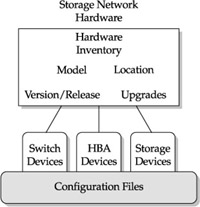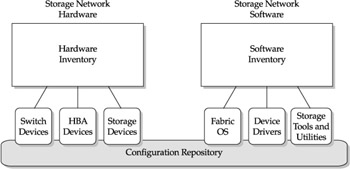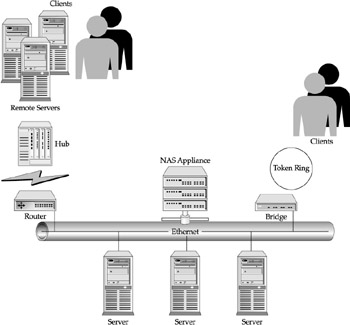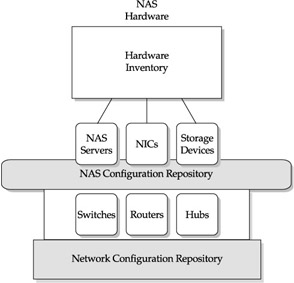Tracking the Configurations
| |
Computer systems require the installation of multiple components that, when working together, form some type of system for producing effective results. Generally, those results are productive for the IT organization responsible for the system. The ability to manage the diversity of hardware and software components is referred to as configuration management. Configuration management establishes the inventory of a system, naming the components , their release and maintenance levels, and connectivity. Although configuration management is suited for both hardware and software, it is usually used in a segregated manner to track the hardware configuration and the software release levels, respectively.
Although the premise is that by keeping track of the components within the hardware or software configuration one can understand the economics in terms of tracking capital equipment, the alternative but oft-unused value of this discipline is the tracking of the inventory to understand what changes can be made, under what circumstances, in order to either correct a system deficiency or enhance the performance of the system to meet established service levels. Given that both hardware and software are likely to change over the effective life of a system, configuration management serves as both a driver to changes and a tool to identify problems.
Storage networking, being that its a system, and a relatively new system at that, can benefit greatly from configuration management. Establishing an effective servicing practice for storage networking systems, and keeping track of the diversity of components that make up SAN or NAS infrastructures , can be extremely valuable .
Whats different about SANs in configuration management is the number of separate components that make up the configuration. In addition to its diversity, the shared characteristics of both networking and storage technologies gives SANs a hybrid view to many people uninitiated in storage networking. At the same time, the SAN infrastructure is driven by the external effects of other compatible and collaborative systems, such as servers, networks, and software.
NAS poses a more chameleon-like problem. NAS configurations can be single or multiple in number, and while looking like storage, they are really a specialized server. This provides a configuration management discipline with some interesting problems in determining where to categorize this component and what elements make up the components. If its a storage device, then it has no OS. However, NAS most definitely has an OS that needs upgrades, changes, and has the potential for problems. However, tracking as a storage device overlooks these critical elements. In addition, NAS configurations are driven externally by the network and remote servers or clients that contact it through remote communications.
The point is that storage networks, although computer systems in and of themselves , are different animals when it comes to categorizing them through traditional configuration management practices. Some thought must be given to these configurations as they are integrated into either existing configuration management tools or are used in establishing new practices that integrate both an inventory tracking for capital expense purposes and a foundation for tracking problems and change.
Physical Configuration Management for SANs
Configurations are likely viewed from a hardware and software perspective. Physical views of the SAN should provide the inventory of all equipment installed within the configuration. This requires all the typical information necessary for asset and capital inventory tracking, such as serial numbers , location, and ownership. In addition, there should be the same current information on firmware or micro-code releases and install dates. Many components in the SAN area come with some type of firmware, micro-code, and micro-kernel software that is release- and hardware-specific. Its important that this information is collected and stored, at a minimum, on a file, although a database is better for later access.
Thus, a decision will have to be made here in terms of categorization of software. Given that firmware and micro-code are hardware-specific, the micro-kernel that functions as the fabric OS must have a place here or in the software configuration tracking system. Consequently, the choice depends on the size of the configuration and what type of distinction there is between hardware and software support for servicing. In a large installation, this could be critical when it comes to avoiding confusion in tracking microkernel release levels in two places, or dodging confusion with other firmware and driver software that is specific to HBA and storage array controllers.
Figure 23-1 indicates the types of categories that may be considered in establishing the configuration management repository for SANs. Of course, this information can and should drive the digital rendering of the configuration for general reference and access.

Figure 23-1: SAN configuration management categories
Logical/Software Configuration Management for SANs
The logical configuration refers to the SAN software, but also should include the logical relationships that exist within the SAN configuration. These are the fabric zones, the LUN assignments at the server/HBA node, and the storage controller array nodes. In addition, there are additional elements within the fabric operating system that relate to the port IDs, fabric logins, worldwide naming services, and the management information base dictionary and layouts.
Configuration management for the logical and software functions is critical. Due to the diversity and complexity of the SAN software components, much time can be saved and downtime avoided through the effective documentation and monitoring of the fabric micro-kernel release and maintenance level, the HBA driver code release and maintenance level, and the storage array RAID driver and firmware release level. There should be an established configuration management for the attached servers. If not, the server OS release and maintenance levels will be mandatory.
Essentially, the software components of the SAN form a matrix of interdependent functions. A change in any has the potential to cascade problems throughout the SAN configuration. You can rely on interoperability labs of vendors , industry groups, and testing labs, to gather macro level compatibility information. However, the number of permutations far exceeds what these well-intentioned groups can provide. If that means providing a test bed for your applications within the configurations specific to your site, then its well worth considering. In fact, its no different than other test beds that you may require for application and system testing and should be integrated into testing facilities.
Figure 23-2 illustrates the configuration management categories and example specifications a data center may consider for SAN physical and logical components. The interrelationships and dependencies between components can quickly become overwhelming, which provides additional justification for building a repository of physical and logical components. However, one of the most difficult events to track are the dependencies from hardware to software components. Consequently, the ability to begin an integrated repository may save critical time as configuration changes can be tracked against the related hardware and software device dependencies.

Figure 23-2: Integrating SAN physical and logical categories into a single repository
Physical Configuration Management for NAS
Managing the physical configurations for NAS might seem like a simpler process than SAN, but its not. The physical connections within the NAS configurations may be simple if they are installed in close proximity and operate within the confines of the data center. Even then, it can become confusing and a challenge because of the diversity of networks and network components. The network becomes the critical factor in establishing the configuration, and consequently, the NAS configurations pose a relatively difficult problem in regards to configuration managementthat is, how to articulate and track individual components of the device and the external characteristics of the network hardware within the context of a system (in other words, the infrastructure).
Figure 23-3 illustrates the complexity of the external relationships between the network, the NAS device, and the attached servers. In a sense, it can be viewed as a loosely connected storage network, with dependencies associated with network topologies and protocols, server nodes, and file communications protocols. Unless the hardware and firmware release levels are inventoried and tracked in conjunction with the network, the NAS systems become unassociated storage servers unbound to the confines of the networks in which they operate. Bottom line, if there is a problem within the NAS device thats being perpetuated through the operations of a network device, the problem will be hard to diagnose and will likely repeat regardless of any changes within the offending NAS device.

Figure 23-3: The complexity of NAS external relationships
Consequently, its paramount that some type of relationship be established as the configuration management is instituted for the NAS configurations. This may require the NAS device being subsumed into the network configuration management disciplines, if they are established; however, this may not take into account the other relationship of the server component that is actually generating the I/O request. Given this third variable, the NAS configuration management must rely on two external factors for effective configuration management: the network and the server. Whether these are accounted for in the network disciplines or the system disciplines or a new storage network discipline, the benefits to problem investigation and upgrade analysis, as well as overall availability, are large.
Figure 23-4 indicates the types of categories that may be considered in establishing the physical configuration management matrix for NAS. Note that due to the complexities of the external relationships of the network devices, links into a network configuration repository enhance the value of the NAS physical configuration information. Of course, this information can, and should, drive the digital rendering of the configuration for general reference and access.

Figure 23-4: NAS configuration management categories
Logical/Software Configuration Management for NAS
Software for NAS becomes both simple and problematic. Simple in terms of the standardization of the NAS micro-kernel OS used, given that the configuration is a homogeneous vendor solution. Problematic in terms of how the NAS OS reacts to a network environment of heterogeneous components (for example, hubs, routers, and switches). Coupled with this is the reaction to a heterogeneous environment of server OSs that may cover both UNIX and Windows variants.
Given that the NAS micro-kernel forms a barrier to direct communications from remote clients to the storage arrays through file access, the storage arrays associated with the NAS solution are bundled and protected from extraneous and external access. The NAS storage upgrade path may be non-existent on entry-level devices and limited to specific vendor upgrades with larger enterprise-level devices. The RAID controller firmware will thus be important to problem investigation associated with vendor servicing.
Configuration management within the NAS infrastructure must encompass the NAS micro-kernel release and maintenance level, the storage RAID controller firmware release and maintenance level, and the network driver release and maintenance levels. These fundamental parts can be associated with network software, network components, and server OS release and maintenance levels to form an effective NAS configuration relationship matrix.
The logical constructs of NAS configuration can be valuable in micro views of the data storage strategies used in the NAS devices. In other words, these are the logical views of RAID deployment within the arrays with configurations like local mirroring and remote mirroring illustrating the synchronization methods used. Integrated with the logical storage information, the logical views of file system extensions supported by the NAS device should be documented.
Figure 23-5 indicates the types of categories that may be considered in establishing the software and logical configuration management matrix for NAS. The complexities of integrating both hardware and software should be taken in context with other configuration management files, repositories, and tracking mechanisms. Figure 23-5 suggests the linking of not only the network inventory but the systems inventory of application and database servers and related information. Of course, this information can, and should, drive the digital rendering of the configuration for general reference and access.

Figure 23-5: NAS software and logical views with example categories
| |
EAN: 2147483647
Pages: 192